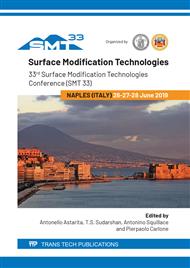p.304
p.310
p.316
p.322
p.328
p.334
p.340
p.346
p.352
Surface Plasma Nitriding of Beta-Titanium Alloy Bio-Material
Abstract:
Ti alloys have been intensely used for human implants due to its excellent characteristics, like bio-inertness, low density, and corrosion resistance. However, some alloying elements were found to be toxic for the human body, which restricts the use of some alloys. Furthermore, there are two additional and essential aspects to be considered. The first relates to the young modulus that, despite being lower than other alloys commonly used for this purpose, it is still far over from the human bone modulus. Such high modulus can result in the stress shield phenomena and the consequent implant losing. The second aspect relates to the fact that bio-inertness does not guarantee a complete tissue integration to the implant and, consequently, the expected implant performance. In this context, new low modulus b-Ti alloys containing nontoxic elements have been developed in recent years, and several surface modification processes have been proposed to promote better implant/tissue integration.In the present work, the new b-type Ti-Mo-Zr-Fe alloy has been submitted to a plasma enhanced chemical vapor deposition (PECVD) process in order to form a superficial titanium nitride layer, aiming to produce a satisfactory substrate for the tissue cells growing. In a first step, microstructural characterization and corrosion performance of the modified alloy surface has been evaluated by Electrochemical Impedance Spectrometry and Potentiodynamic testing, and the results compared to the unmodified alloy. It was found that during the plasma nitriding process, that runs at 550°C for 1h, the metastable b microstructure is partially converted into a’ and possibly a” phases, which can impact the young modulus. The 500nm thick TiN layer formed over the alloy surface improved the corrosion behavior of the alloy. These results encourage the continuity of the research, with the future in vitro bio-activity testing of the nitrided surface.
Info:
Periodical:
Pages:
328-333
Citation:
Online since:
July 2019
Keywords:
Price:
Сopyright:
© 2019 Trans Tech Publications Ltd. All Rights Reserved
Share:
Citation:



